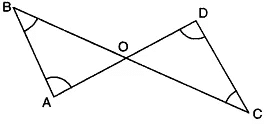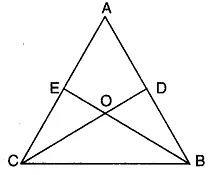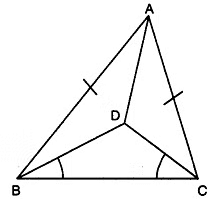Class 9 Maths Chapter 6 Previous Year Questions - Triangles
Very Short Answer Type Questions
Q1. In ΔABC, ∠ B = 60° and ∠ C = 63°. Name the greatest side. [2025]
 View Answer
View Answer 
Sol. In ΔABC, ∠ B = 60° and ∠ C = 63°

⇒ ∠ A = 180º - (60° + 63°) = 57°⇒ The greatest side is opp. to the greatest angle, i.e., 63°∴ Side AB is the greatest.
Q2. In ΔABC, if BC = AB and ∠ B = 80°, then find the measure of∠ A. [2024]
 View Answer
View Answer 
Sol. BC = AB ⇒ ∠A = ∠C

∵ ∠B = 80°
∴ ∠A + ∠C = 180° - 80° = 100°
⇒ ∠A = ∠C = 50º
Q3. Which of the following is not the criterion for congruence of triangles? [2023]
(i) SAS (ii) SSA (iii) ASA (iv) RHS
 View Answer
View Answer 
Sol. SSA is not the criterion for congruency.
Q4. If two angles are (30 - a)º and (125 + 2a)º and they are supplement of each other. Find the value of ‘a’. [2022]
 View Answer
View Answer 
Sol. ∵ (30 - a)º and (125 + 2a)º are supplement to each other.
∴ (30 - a + 125 + 2a)º = 180º
⇒ a = 180º - 125º - 30º = 25º
⇒ Value of a = 25°
Q5. Find the measure of each acute angle in a right angle isosceles triangle. [2021]
 View Answer
View Answer 
Sol. Let the measure of each of the equal acute angle of the Δ be x
∴ We have: x + x + 90° = 180°
⇒ x + x = 180° - 90° = 90°
⇒ x= (90o/2)= 45°
Short Answer Type Questions
Q1: In the given figure, if ∠1 = ∠2 and ∠3 = ∠4, then prove that BC = CD. [2025]
 View Answer
View Answer 
Sol:

In ∆ABC and ACDA, we have
∠1 = ∠2 (given)
AC = AC [common]
∠3 = ∠4 [given]
So, by using ASA congruence axiom
∆ABC ≅ ∆CDA
Since corresponding parts of congruent triangles are equal
∴ BC = CD
Q2: In the given figure, AC > AB and D is a point on AC such that AB = AD. Show that BC > CD. [2023]
 View Answer
View Answer 
Sol:

Here, in ∆ABD, AB = AD
∠ABD = ∠ADB
[∠s opp. to equal sides of a ∆]
In ∆BAD
ext. ∠BDC = ∠BAD + ∠ABD
⇒ ∠BDC > ∠ABD ….(ii)
Also, in ∆BDC .
ext. ∠ADB > ∠CBD …(iii)
From (ii) and (iii), we have
∠BDC > CD [∵ sides opp. to greater angle is larger]
Q3: In the given figure, ∠B < ∠A and ∠C < ∠D. Show that AD < BC. [2022]
 View Answer
View Answer 
Sol:
Here, ∠B < ∠A
⇒ AO < BO …..(i)
and ∠C < ∠D
⇒ OD < CO …..(ii)
[∴ side opposite to greater angle is longer]
Adding (i) and (ii), we obtain
AO + OD < BO + CO
AD < BC
Q4: In a triangle ABC, D is the mid-point of side AC such that BD = 1/2 AC. Show that ∠ABC is a right angle. [2021]
 View Answer
View Answer 
Sol:
Here, in ∆ABC, D is the mid-point of AC.
⇒ AD = CD = 1/2AC …(i)
Also, BD = 1/2AC… (ii) [given]
From (i) and (ii), we obtain
AD = BD and CD = BD
⇒ ∠2 = ∠4 and ∠1 = ∠3 …..(iii)
In ∆ABC, we have
∠ABC + ∠ACB + ∠CAB = 180° [Angle sum property]
⇒ ∠1 + ∠2 + ∠3 + ∠4 = 180°
⇒ ∠1 + ∠2 + ∠1 + ∠2 = 180° [using (iii)]
⇒ 2(∠1 + ∠2) = 180°
⇒ ∠1 + ∠2 = 90°
Hence, ∠ABC = 90°
Q5: In the given figure, it is given that AE = AD and BD = CE. Prove that ∆AEB ≅ ∆ADC. [2020]
 View Answer
View Answer 
Sol:
We have AE = AD … (i)
and CE = BD … (ii)
On adding (i) and (ii),
we have AE + CE = AD + BD
⇒ AC = AB
Now, in ∆AEB and ∆ADC,
we have AE = AD [given]
AB = AC [proved above]
∠A = ∠A [common]
∴ By SAS congruence axiom, we have
∆AEB = ∆ADC
Q6: In the given figure, ∆ABC and ∆DBC are two isosceles triangles on the same base BC and vertices A and D are on the same side of BC, AD is extended to intersect BC at P. Show that : (i) ∆ABD ≅ ∆ACD (ii) ∆ABP ≅ ∆ACP [2019]
 View Answer
View Answer 
Sol:
(i) In ∆ABD and ∆ACD
AB = AC [given]
BD = CD [given]
AD = AD [common)]
∴ By SSS congruence axiom, we have
∆ABD ≅ ∆ACD
(ii) In ∆ABP and ∆ACP
AB = AC [given]
∠BAP = ∠CAP [c.p.cit. as ∆ABD ≅ ∆ACD]
AP = AP [common]
∴ By SAS congruence axiom, we have
∆ABP ≅ ∆ACP
Long Answer Type Questions
Q1: In right triangle ABC, right-angled at C, M is the mid-point of hypotenuse AB. C is joined to M and produced to a point D such that DM = CM. Point D is joined to point B (see fig.). Show that : (i) ∆AMC ≅ ∆BMD (ii) ∠DBC = 90° (ii) ∆DBC ≅ ∆ACB (iv) CM = 1/2AB [2025]
 View Answer
View Answer 
Sol:
Given : ∆ACB in which 4C = 90° and M is the mid-point of AB.
To Prove :
(i) ∆AMC ≅ ∆BMD
(ii) ∠DBC = 90°
(iii) ∆DBC ≅ ∆ACB
(iv) CM = 1/2AB
Proof : Consider ∆AMC and ∆BMD,
we have AM = BM [given]
CM = DM [by construction]
∠AMC = ∠BMD [vertically opposite angles]
∴ ∆AMC ≅ ∆BMD [by SAS congruence axiom]
⇒ AC = DB …(i) [by c.p.c.t.]
and ∠1 = ∠2 [by c.p.c.t.]
But ∠1 and ∠2 are alternate angles.
⇒ BD || CA
Now, BD || CA and BC is transversal.
∴ ∠ACB + ∠CBD = 180°
⇒ 90° + CBD = 180°
⇒ ∠CBD = 90°
In ∆DBC and ∆ACB,
we have CB = BC [common]
DB = AC [using (i)]
∠CBD = ∠BCA
∴ ∆DBC ≅ ∆ACB
⇒ DC = AB
⇒ 1/2AB = 1/2DC
⇒ 1/2AB = CM or CM = 1/2AB (∵ CM = 1/2DC)
Q2: In figure, ABC is an isosceles triangle with AB = AC. D is a point in the interior of ∆ABC such that ∠BCD = ∠CBD. Prove that AD bisects ∠BAC of ∆ABC. [2022]

 View Answer
View Answer 
Sol:
In ∆BDC, we have ∠DBC = ∠DCB (given).
⇒ CD = BD (sides opp. to equal ∠s of ∆DBC)
Now, in ∆ABD and ∆ACD,
we have AB = AC [given]
BD = CD [proved above]
AD = AD [common]
∴ By using SSS congruence axiom, we obtain
∆ABD ≅ ∆ACD
⇒ ∠BAD = ∠CAD [c.p.ç.t.]
Hence, AD bisects ∠BAC of ∆ABC.
Q3: Prove that two triangles are congruent if any two angles and the included side of one triangle is equal to any two angles and the included side of the other triangle. [2021]
 View Answer
View Answer 
Sol:

Given : Two As ABC and DEF in which
∠B = ∠E,
∠C = ∠F and BC = EF
To Prove : ∆ABC = ∆DEF
Proof : We have three possibilities
Case I. If AB = DE,
we have AB = DE,
∠B = ∠E and BC = EF.
So, by SAS congruence axiom, we have ∆ABC ≅ ∆DEF

Case II. If AB < ED, then take a point Mon ED
such that EM = AB.
Join MF.
Now, in ∆ABC and ∆MEF,
we have
AB = ME, ∠B = ∠E and BC = EF.
So, by SAS congruence axiom,
we have ΔΑΒC ≅ ΔΜEF
⇒ ∠ACB = ∠MFE
But ∠ACB = ∠DFE
∴ ∠MFE = ∠DFE

Which is possible only when FM coincides with B FD i.e., M coincides with D.
Thus, AB = DE
∴ In ∆ABC and ∆DEF, we have
AB = DE,
∠B = ∠E and BC = EF
So, by SAS congruence axiom, we have
∆ABC ≅ ∆DEF
Case III. When AB > ED
Take a point M on ED produced
such that EM = AB.
Join MF
Proceeding as in Case II, we can prove that
∆ABC = ∆DEF
Hence, in all cases, we have
∆ABC = ∆DEF.
|
40 videos|471 docs|57 tests
|
FAQs on Class 9 Maths Chapter 6 Previous Year Questions - Triangles
| 1. What are the different types of triangles based on their angles? |  |
| 2. How can you determine if three given sides form a triangle? |  |
| 3. What is the Pythagorean Theorem and how is it used in triangles? |  |
| 4. How do you find the area of a triangle using its base and height? |  |
| 5. What is the sum of the interior angles of a triangle and how is it calculated? |  |






















